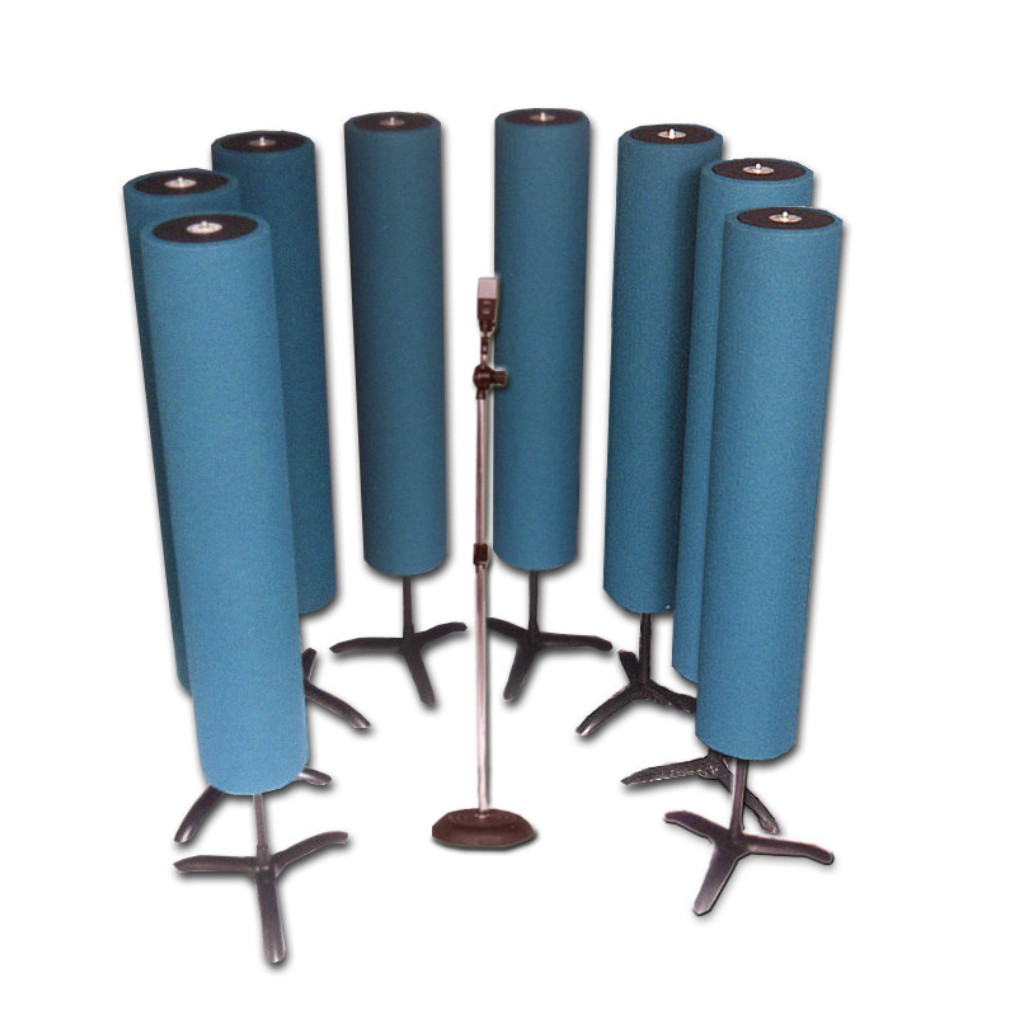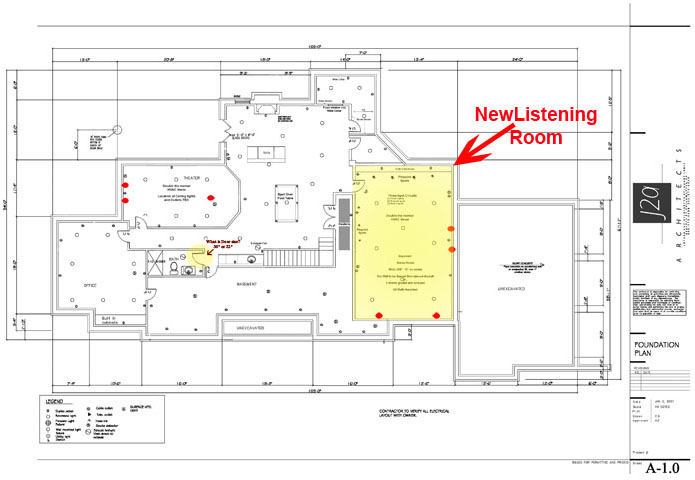View as PDF
Usually the call from a church goes something like this: Hi, well, I’m from the building committee and we built out church last year and ran way over budget. We spent the acoustic budget on the drain field. We were wondering how much it would cost to fix the sound in our church? Oh we already have expensive speakers, it’s just that we can’t understand what’s being said.
Or sometimes it sounds something like: Hi, we are a small church and don’t have any money. We hoped you could help us. We can’t understand the pastor. We know you fix lots of churches and we were thinking you might be willing to give us a little advice. Oh, we’re very handy and we plan to make everything ourselves.
And then there is always: Hi. I’m with the music committee. We are in an historic church and the building committee won’t let us do anything. Can you help us convince them we need to do something about the choir? We have microphones and monitors strung all over and we still can’t sing right.
Here’s another one: Hi, I’m from the praise band. We spent all our money on speakers and a new mixer and the band still doesn’t sound good. Now what?
Usually, working with churches is pretty hard. But one day I got the dream call. It went something like this: Hi. We had some vandals start a fire and our church was smoke damaged. It was covered by insurance and the entire inside of the church needs to be removed and resurfaced. We figure we can use this money to do the acoustic job we always needed, and still get the painting done. So what do we do?
Getting Started
There is nothing better than the opportunity to start a project off with a blank canvas and a blank check.
I walked in and saw that the church had a large square floor plan, with the platform centered along one wall. It had a high flat ceiling with deep glulam beams to span the width. The 4 corners were each cut off and a door was set in each diagonal. Carpets were pulled and the walls and varnished wood ceiling had been washed. The side room had a folding door and was used for additional seating. That’s where the fire was and the opening had been walled off. That part of the building was torn down and replaced by a kitchen/fellowship hall. The fire had been started in the newspaper collection bin outside. No they didn’t catch whoever did it.
The music minister greeted me and we talked about how music was used in the service. They had a praise band and a traditional choir and sometimes even, they made music together. They also had a soloist who led in song and prayer. Projectors lit the diagonal walls on either side of the platform, with the words of the song and other images.
The sound was being run from a bench at the back of the church, under the spot deck. Problem with the sound is that they couldn’t hear what the congregation heard so they always had to get up, walk down the aisle and then guess at an adjustment. And as well, congregational singing was very important.
Then I met the minister. A great guy and his daughter was the very talented and energetic soloist. His goal was that the music ministry work and of course that his talks would be well heard in all parts of the church. He had a big voice, and probably didn’t need any sound system, but used one anyway.
The current sound system was a giant, 3 bay custom system, dating back to the late 70s, beautiful wood, about 6’ deep and 8’ wide. It was bolted to the face of the beam that ran right across the front of the platform. They thought the system never sounded right and that they wanted to replace it.
A sound contractor was also involved with the project. He naturally wanted to run lots of mic and speaker cables, hang lots of white speakers, mains, monitors and fill speakers and hang lots of microphones. He wanted to snake all this together and into the brand new board at the back of the hall. And he did do all of that.
“My tools are sound absorption and sound reflection.”
As for me, I was working on acoustics. My job was two fold. One was to make sure everyone who was performing in the church would find themselves performing in a space that was not only suitable to their performance but one that complimented it. Secondly, that everyone who was not performing was able to cleanly hear the performing members.
In a way the sound contractor and I had sort of the same job description but we went about our work in very different ways. We both managed sound but the sound contractor managed sound by collecting it using mics and recreating it using loud speakers. I manage the sound once the sound has been launched into the air, it is my job to see to it that airborne sound behaves properly. My tools are sound absorption and sound reflection.
Band and Choir Location
The minister gave his blessing and left. I went to work with the music minister and a few musicians. The first question was about the location of the band and the choir. The band was scattered across the stage and the choir was on carpet risers centered at the back of the platform, below the cross and in front of the baptismal. The modesty railing was removed in the 80s and the platform was strewn with mic cables, water bottles, back packs, guitar cases, music and lots of big black angled up monitor boxes. Worship has changed so much over the years, this ministry platform didn’t really look much like a church at all.
I asked about all the mess, if that was agreeable, and no one liked it but also, no one much paid any attention to it, it’s just how things are these days. I asked about the modesty railing and well, it got pulled, somewhere along the line, trying to open up the space between the ministry and the congregation. I asked if I could sketch out on the floor an arrangement I had found to be useful sometimes when it came to platform organization.
I started by centering the pulpit and putting a few guest chairs behind. Then I took a bunch of tables and tipped them on their side, using the opened up legs to support them on their long edge. Set back from the front of the platform by about 10 feet, I created two fenced off spaces, symmetrical on the platform, one on the left and one on the right. Up the middle and behind the pulpit, between these two spaces, was a path bordered by a low railing on each side. It led right up to the baptismal and the cross. The praise band gear was moved to the right of the pulpit, and the choir risers were moved to the left of the pulpit. The piano was placed in front of the modesty railing in front of the band. The lid was up and directed clear sound to the band. The pianist had a clear line of sight not only to the band, but to the choir and to the front center area where the song leader and pastor were located.
I explained that the praise band actually needs to play in a recording studio and the choir actually needs to sing in a choir loft. But here they were on top each other on a carpeted platform in a giant sheetrock box. We just have to give each performing group their proper place, space and sound. The inside of the praise band space would be treated with alternating acoustic surfaces, mainly. The inside of the choir space would be treated with sound reflecting surfaces. Carpet would be used in the praise band area and a polished wood floor would be used in the choir area.
An amplified band cannot play in a sound reflecting space. An acoustic choir cannot sing is a sound absorbed space. Each needs its own acoustic space. Granted, these spaces are only half spaces, as the upper half of each space expands out into the whole volume of the church. But even a half a proper space is oh so much better than no proper space.
The first 4 or 5’ of the side and back walls where the praise band is located as well as the inside surface of the surrounding modesty railing would be covered with an alternating pattern of 2” thick sound panels, 6” wide vertical strips of sound panel alternating with painted sheetrock. This greatly softens and diffuses the lower wall reflections all around the band. Microphones no longer are being hammered by sound reflections from the floor monitors, off the wall behind and back into the mic. The sound engineer discovers the mics have lots more gain before feedback. The talent doesn’t have to “eat” the mics to sound good and loud. The congregation gets to see happy smiling mouths singing instead of singers with big black wind balls for a mouth.
 The congregation no longer sees cables, monitors, water bottles, sheet music, and guitar cases. They just see people from the knees up, looking sharp and happy. The view of the praise band is at last, clean and organized. And something else happens. In the old days, if you asked the sound engineer sitting in the back of the church what the mains, the bug speakers up front, were set at, he’s smile a little and tell you that the mains were turned off. Here we had these giant, expensive house speakers, turned off. Why? Because there was so much noise on the platform, band noise, that the band monitors had to be turned up pretty loud, so loud that the sound from the monitors expanded backwards, right off the front of the platform and into the congregation. What didn’t expand backwards, shot past the musicians and bounced off the front wall of the church and then back across the platform and finally into the congregation. The monitor sound from the platform was so loud, that the big house main speakers weren’t needed.
The congregation no longer sees cables, monitors, water bottles, sheet music, and guitar cases. They just see people from the knees up, looking sharp and happy. The view of the praise band is at last, clean and organized. And something else happens. In the old days, if you asked the sound engineer sitting in the back of the church what the mains, the bug speakers up front, were set at, he’s smile a little and tell you that the mains were turned off. Here we had these giant, expensive house speakers, turned off. Why? Because there was so much noise on the platform, band noise, that the band monitors had to be turned up pretty loud, so loud that the sound from the monitors expanded backwards, right off the front of the platform and into the congregation. What didn’t expand backwards, shot past the musicians and bounced off the front wall of the church and then back across the platform and finally into the congregation. The monitor sound from the platform was so loud, that the big house main speakers weren’t needed.
 But now the modesty railing is acoustically lined. Also the lower part of the front wall, behind the band is also acoustically lined. The sound from the stage monitors is absorbed and before it can get into the congregation. And yet the monitor sound is still plenty loud for the band. Something else happened. Because the band is closer together and located inside the lower half of a recording studio, acoustically speaking, they can hear each other playing. They don’t need the monitors as much and they turn their thumbs down at the engineer in back who is setting up the monitor mix. The monitor level is turned down, and the congregation hears even less. And when the monitor levels are turned down, there is even more gain before feedback and that means even more dynamic range or stepback from the mic for the talent.
But now the modesty railing is acoustically lined. Also the lower part of the front wall, behind the band is also acoustically lined. The sound from the stage monitors is absorbed and before it can get into the congregation. And yet the monitor sound is still plenty loud for the band. Something else happened. Because the band is closer together and located inside the lower half of a recording studio, acoustically speaking, they can hear each other playing. They don’t need the monitors as much and they turn their thumbs down at the engineer in back who is setting up the monitor mix. The monitor level is turned down, and the congregation hears even less. And when the monitor levels are turned down, there is even more gain before feedback and that means even more dynamic range or stepback from the mic for the talent.
While the praise band is singing praises because of their acoustically tricked out modesty railing, the choir is warming up. The choir space has been stripped of all carpet and all soft chairs. It’s a wood floor, wood risers, wood chairs and wood all around the choir, both on the back of the modesty raining and on the lower walls to the back and side of the choir. This wood has the same relief pattern and coloring as the praise band. A raised 6” wide piece of wood alternates with 6” wide wall spaces. Because the coloring is the same on both sides, a sense of whole and symmetry is visually developed, even though the actual material making the 6” wide, 2” deep vertical strips is very different. In the choir area this wood relief pattern helps to scatter the choir sound so that the members hear each other better.
A choir cannot hold a tune outdoors on a grassy knoll. A choir loft is a special room invented to get choirs to sound great. It is an ancient invention and something that old is not to be toyed with. Sound contractors like to hang lots of microphones and place lots of self powered monitor speakers and a choir mix console, with lots of cords running all over the place. The acoustic engineer can do the same thing acoustically, if the building committee allows even half a choir loft to be built on the platform. The hard and sound scattering surfaces that surround the choir cause part of their sound to be reflected and to reverberate right around the members of the choir. Because they can hear themselves and each other they can quickly get in tune, in tempo and on time. Most anyone loves to sing in the shower. The choir loves to sing in even a half a choir loft. The other half lies open to the congregation, where they not only hear the happy choir, but they also hear the blended reverberant sound of the choir loft adding to the power of the choir.
Congregational Acoustics
Now that the music ministry has been realigned, set up and is running happy, it’s time to turn the attention to another singing group, the congregation. Congregational singing is also important, and the rules that govern choir singing, also govern congregational singing. Let’s stop for a minute and think about singing. Not pop singing, but church singing, it’s singing about something very important, very dear to us. Singing is but one step away from crying. We know that and can feel that. And the best congregational singing leaves us in tears, half singing and half crying. We know where this congregational singing is going, straight to the heart. The acoustic engineer wants to help people in the congregation lose themselves in song.
If the congregational area is too “dead” which means it has no acoustic reflections, and no reverberation, then people become timid. It’s about loudness. If the singing around you is so loud that you can barely hear yourself, you get real brave and sing all the louder. Which raises the loudness for those around you, and they sing all the louder and so on it spirals up. To lose one’s self in song, means to lose one’s self consciousness, which means to no longer feel that you are standing out in the crowd, but that you feel you are lost in the crowd. Good acoustics can help this to happen, and bad acoustics will keep it from happening.
Good congregational acoustics means that the surfaces nearby are reflective. The floor is not carpet and the seats are not cushioned. The surfaces near the congregation are reflective. The lower half of the congregation area side walls must be reflective, no sound panels on the lower side or back wall of the congregational area. The ceiling above the congregation should not be acoustic tile because this absorbs sound. It should be a hard reflective surface, as in painted sheetrock, concrete, plaster or wood. Beams in the ceiling are great if they run side to side, because those overhead corners back scatter upward moving sound right back into the congregation.
The congregation needs to be a loud place. If you stand up in the middle of the congregational area and make one loud hand clap, you should hear sound ricocheting between the side walls, it’s called flutter echo. Of course the aisles do need to be carpeted. This makes for sure footing and much less clatter coming in and leaving. And if there are cushions, then flat vinyl should be used, not fabric.
The lower half of the side and back wall of the congregational area are left reflective. This is a great place to locate glass windows with deep shrubbery outside to get a sense of openness, keep the reflective walls and maintain privacy. Because of the lower bare walls, the house sound system, any loudspeakers directed towards the congregation must be located well above, in the upper half of the volume of the room. This way the lower wall reflections will simply bounce into and help to fill in sound in the back parts of the seating area.
 Today people do not like huge speakers hanging up high above the pastor. They want small speakers, unobtrusive. This goes well with something else. Split the sound system. Dedicate the high central cluster speaker to the voices of the pastor, soloist and prayer leader. Put a pair of large mains up high, one in each of the two front corners of the hall for the band and any choir mics. The house mix comes from these two speakers, and the house mix is always mono, never stereo. This way the high central cluster stays small because it is for voice only. The house mains are huge because they are full music bandwidth, play louder and have more dynamic range.
Today people do not like huge speakers hanging up high above the pastor. They want small speakers, unobtrusive. This goes well with something else. Split the sound system. Dedicate the high central cluster speaker to the voices of the pastor, soloist and prayer leader. Put a pair of large mains up high, one in each of the two front corners of the hall for the band and any choir mics. The house mix comes from these two speakers, and the house mix is always mono, never stereo. This way the high central cluster stays small because it is for voice only. The house mains are huge because they are full music bandwidth, play louder and have more dynamic range.
There is something comforting about having the pastor’s voice coming from the speaker directly above the pastor. Our ear does not notice the height and the sound seems to come directly from the pastor. Our listening is very sensitive to sound coming from the left and right and if the pastor’s voice came from the house mains, on either side, in the corners, then the pastor would seem to be in one spot and the voice in another. They would be split in location, and this is simply distracting. We want the pastor’s message to be seamless.
The speakers also need an acoustic environment. The upper half of the front third of each side wall does need some blend of absorption and reflection. The upper half of the entire back wall does need the same pattern of acoustic improvement. If the ceiling is flat and the floor under the speakers is not carpeted, the ceiling area directly above each speaker will need acoustic conditioning. Any portion of a ceiling beam that directly faces a loudspeaker, needs to be acoustically conditioned. Note that the speaker side of a beam may have acoustic panels but the congregation side of the same beam will be bare and reflective. One side faces the speaker and the other side faces the congregation. Each side helps to create an appropriate acoustic space for some or another sound source.
A Happy, Inconspicuous Ending
The end of the story is that the ministry and music people believed my show and tell story and everything was built exactly as specified. And now, when you walk in for service, things look fine and they sound fine. The band sounds fine and the choir sounds fine. The pastor, soloist and prayer leaders sound fine and congregational singing is just fine. In effect, nothing special seems to stand out, acoustically.
The room is neither dead nor loud, or otherwise unusual. In fact the whole experience appears seamless, acoustically invisible. And yet, the church service as powerful and engaging as it can be. Everyone hears and no one complains. It takes a little getting used do, but the fact is that people don’t seem to notice the sound…..in a good sounding church.








